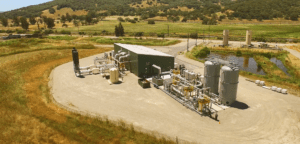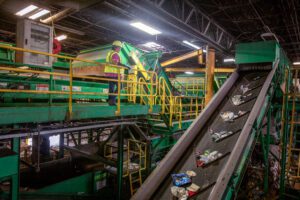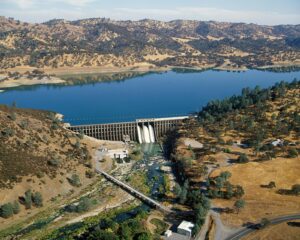Serving Marin County Since 1958
All of us at the Redwood Landfill and Recycling Center are extremely proud of our facility. We have been providing safe, reliable and environmentally-sound disposal services to the North Bay since 1958. Our recycling, composting and reuse programs play a vital role in helping Marin County reach its goals of reduced waste and lower emissions. Nearly one-half of the materials brought to the site is reused, recycled or composted. By generating clean, renewable electricity from landfill gas, we’re also helping to displace an estimated 8,000 metric tons of greenhouse gas annually.
Landfilling
Materials that cannot be diverted for recycling or composting are disposed at the working face of the landfill. Throughout the day, heavy equipment operators crush and compact the waste into the disposal cell. This process forms a tightly packed layer of waste, reduces settlement and conserves landfill space.
At the end of each day, bulldozers spread a layer of compacted soil or alternative cover (such as sludge mixed with wood waste) over the exposed garbage. This daily cover, required by law, keeps the waste in place, deters scavenging by animals, helps repel rainwater and minimizes odors.
More About Redwood Landfill and Recycling Center
Size: 420-acre site of which 222.5 acres are dedicated to waste disposal. The nearly 200 remaining acres support composting, recycling and reuse services and operations facilities as well as open space and a fresh water lagoon for migratory water fowl.
Permits: Class III disposal facility for non-hazardous materials. Redwood Landfill meets or exceeds all federal, state, and local requirements for landfill management and is regulated by the California State Water Quality Control Board, Bay Area Air Quality Management District, CalRecycle and the Marin County Environmental Health Services Division.
Capacity: Permitted to accept 2,310 tons of material daily.
History of Redwood Landfill
| 1958 | Jordan Smith, whose family is the namesake for Smith Ranch Road, established the 600-acre Redwood Landfill. |
| 1978 | California created the Integrated Waste Management Board, issuing Redwood its first Solid Waste Facility Permit to accept sludge and solid waste. |
| 1989 | New state and federal regulations governing landfill management went into effect, requiring significant investments by operators to meet the new standards. WM (future owner of Redwood Landfill) working closely with Assembly Member Byron Sher, supported the passage of AB 939, the nation’s first mandatory recycling law. |
| 1991 | Smith sold Redwood Landfill to Sanifill, Inc. |
| 1994 | Redwood Landfill received a temporary permit to begin recycling fill materials. It was a leader in helping Marin comply with the new state recycling mandates. |
| 1996 | USA Waste of California purchased Sanifill, Inc. including ownership of Redwood Landfill. Redwood instituted additional diversion activities, including composting of yard waste, grinding of concrete and asphalt for base rock and gravel and setting aside metals and appliances delivered by self-haulers for recycling. |
| 1998 | WM merged with USA Waste and became the owner and operator of the Redwood Landfill. |
| 2003 | Redwood Landfill transferred ownership of 180 acres of land to the Marin Audubon Society to be restored to tidal wetlands. |
| 2006 | Redwood Landfill designed, managed construction and paid for a $10 million overcrossing of Highway 101 at the entrance to the landfill. |
| 2008 | Received updated Solid Waste Facilities Permit from CalRecycles. |
| 2009 | Received updated Waste Discharge Requirements Permit from San Francisco Regional Waster Quality Control Board. |
| 2010 | Received Title 5 Air Permit from Bay Area Air Quality Management District. |
| 2014 | Constructed Covered Aerated Static Pile (CASP) composting facility, tripling capacity while reducing by 50% the emissions resulting from traditional windrow composting. |
| 2017 | Opened state-of-the-art landfill gas to electricity plant, delivering 3.9 megawatt of renewable electricity to 5,000 MCE customers annually. |




